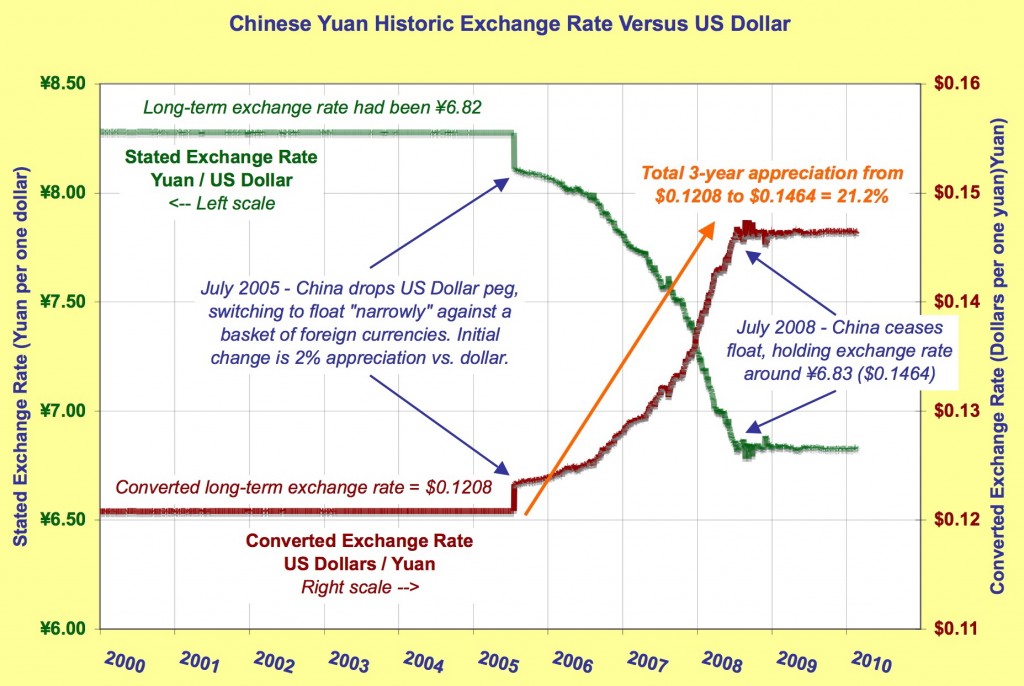The Chinese Yuan’s Anticipated Rise – Investment Implications (Part 2)
 With yesterday’s explanation of exchange rates, we can now examine investment opportunities resulting from a Chinese yuan increase. My focus will be on Chinese company stocks.
With yesterday’s explanation of exchange rates, we can now examine investment opportunities resulting from a Chinese yuan increase. My focus will be on Chinese company stocks.
The easy conclusion is that the yuan’s appreciation means we can earn a bonus return by owning Chinese securities. However, “easy” in investing usually means everyone is already onboard, and there are no added gains to be had. This time, though, I think the uncertainty swirling about is leaving the opportunity on the table. Here is my analysis…
To start, here is a ten-year picture of what’s happened to the yuan’s exchange rate.
Prior to the July 2005 end of the US dollar peg (i.e., fixed exchange rate), China was being pressured to let the yuan float. The arguments were the same then as now. (If interested, you can find articles by web searching for “yuan peg 2005.”) Developed countries rightfully argue that the yuan’s too-low exchange rate gives Chinese companies an artificially low price advantage. Plus the resulting unbalanced trade creates large trade deficits in the developed countries and significant currency flows into China.
The one-year yuan forward contract currently indicates the Chinese will restart the float in a controlled manner, with the yuan up a moderate 2.7% over the twelve months. However, that forecast is an average of diverse expectations, ranging from 0% to much higher than 2.7%. Chinese official statements create the uncertainty.
So, the conclusion we can draw is that the “worst” case is that the yuan stays where it is – meaning the Chinese companies continue to benefit from their pricing advantage. Clearly, that is not a risk to stock ownership because earnings should rise nicely.
More likely is that China will restart their controlled yuan float, leading to an appreciation (probably more than 2.7% in a year, once they begin and the 0% forecasts are disproved). And, here’s where forecasting gets fun. On the surface, companies will lose some pricing advantage. However, there are a number of positive fallouts that come from the yuan appreciation:
- Company earnings and asset values rise in US dollar terms
- The pricing advantage is not spread equally. Some companies sell mainly to local markets, so they are unaffected. And some have unique products or services, allowing them to maintain sales even as prices rise. And some have large competitive pricing advantages, allowing them to hold onto their competitive positions.
- A strong and rising currency gives companies two powerful advantages:
- Access (as allowed by the government) to foreign capital at lower interest rates (because foreign investors will include the yuan’s appreciation in their expected return)
- A valuable tool to acquire foreign assets. Just think of the flip side of the yuan-US dollar exchange rate, from the Chinese standpoint. A yuan rise makes US prices look lower. And we know the Chinese, even the government, are interested in buying foreign assets (see The US Stock Market – From China Perspective, It’s A Desirable Value Play).
- Last is the positive effect on the Chinese populace – the customers. Simply by holding and earning yuan, the currency’s appreciation makes them richer to the rest of the world. Think about travel or buying foreign goods. When the US dollar is up, we have more opportunities. Likewise for the Chinese.
Thus, the yuan’s rising could be advantageous to Chinese stock investors. So, it appears to be a win-win situation.
How about pricing, then? We hear about rapid growth in China – so fast that the government is taking steps to control it. Does that mean prices are high? Actually, no.
While we hear about speculation hitting certain areas (e.g., small stocks and property), there is no general overvaluation. For one thing, there is the uncertainty about the future. Also, even though we used to see pictures of individuals sitting in offices watching their stock holdings, the real drivers of overvaluation in underdeveloped country markets has always been foreign investors. The massive flows of capital available to move into (and out of) such markets can create abnormal gyrations and valuations. With developed country investors still gun-shy about owing stocks, that flow has yet to kick in fully.
So, it looks like a good time to buy some Chinese stocks. The big question then is how? There is limited or no familiarity with Chinese companies by us US investors (even pronouncing their names can be a challenge). This, then, is a perfect time to buy a fund – but which one? Tomorrow, I will discuss finding good choices.





